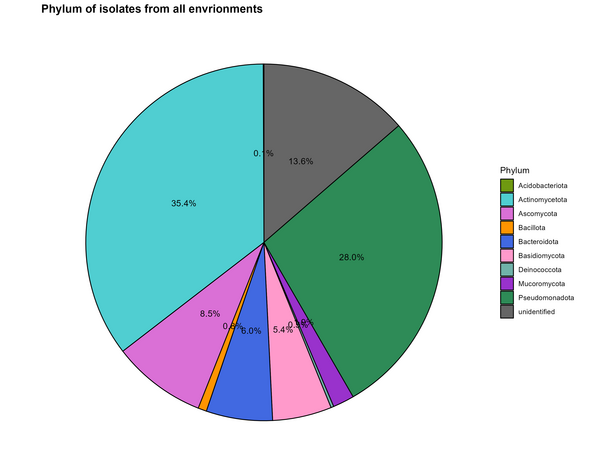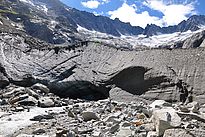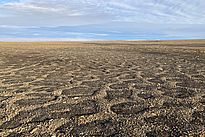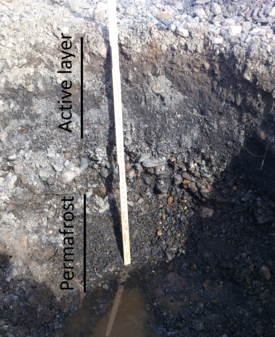Life at chilly temperatures - A collection of microorganisms from extreme habitats
Anja Werz
Beat Stierli
Benedikt Gruntz
Ivano Brunner
Joel Rüthi
2023 - 2028
FinancingThe cold habitats of the Swiss Alps and the Arctic are undergoing change and are at risk of disappearing completely or partially in the future. Along with them, a poorly known diversity of microorganisms that have adapted to life in these supposedly hostile places. By cryopreserving approx. 1'500 microorganisms from these habitats, some of today's biodiversity can be preserved in biobanks.
Content ¶
- What are microorganisms?
- Why are microorganisms from cold habitats being studied?
- From which habitats have microorganisms been isolated?
- What is permafrost?
- What living conditions are microorganisms exposed to in the studied habitats?
- Which microorganisms from the studied habitats also grow under laboratory conditions?
- Isolated Bacteria
- Isolated Fungi
- Frequently asked questions
What are microorganisms? ¶
Microorganisms are living organisms that are not visible to the naked eye. They include bacteria, archaea, microfungi and microalgae, as well as viruses, which are not actually living organisms. It is estimated that there are several million to a trillion different microbial taxa, the majority of which are probably bacteria. Of the estimated diversity of microbial taxa, only a tiny fraction is known to date (~10,000 bacteria; ~400 archaea; ~150,000 fungi, although not all fungi are microorganisms; ~35,000 microscopic algae; ~11,000 viruses), and an even smaller fraction is actually cultivable in the laboratory.
Many terrestrial, marine or human-associated prokaryotic taxa (bacteria and archaea) are found on all continents or in both hemispheres. However, if we look at habitats with more extreme living conditions, we find taxa that are less widespread and only occur in certain places.
Why are microorganisms from cold habitats being studied? ¶
By the end of the century, temperatures in alpine regions will continue to rise, snow cover will decrease, permafrost will thaw, the active layer will reach to greater depths and glaciers will largely disappear.
Higher temperatures than ever before are already being measured in Arctic regions and the area of sea ice in winter is at a record low level. Snow cover and sea ice will become thinner in the future and glaciers will continue to melt. By the end of the century, permafrost will be warmer and will thaw down to deeper soil layers.
The cold habitats in alpine regions such as the Swiss Alps and in Arctic regions will change considerably or even disappear completely in the future. With them, a diversity of microorganisms that have hardly been studied to date will disappear. The cryopreservation of microorganisms from cold habitats in the Swiss Alps and the Arctic can preserve part of the unexplored microbial biodiversity in biobanks.
The cryopreservation of microorganisms from cold habitats is not only intended to learn more from this habitat but also to identify new species. Certain properties that enable microorganisms to survive at cold temperatures could also be of interest for biotechnological, industrial and medical applications or for bioremediation. For example, isolated strains can be examined for the production of secondary metabolites, cold-active enzymes or other useful properties.
Antibiotics have become indispensable in medicine and pesticides are essential for agriculture. Since microorganisms from cold habitats are still little researched, they could be a veritable treasure trove of previously unknown biomolecules with antibiotic, pesticide, antitumor, immunosuppressive, antioxidant or plant growth-promoting properties.
In addition, cold-active enzymes could be used where enzymatic reactions were previously only efficient at elevated temperatures. Microbial polysaccharides or entire microorganisms can be used for bioremediation (e.g. remediation of soil and water contaminated with heavy metals, oil or pesticides) or for wastewater treatment. Microbial surfactants for cleaning at low temperatures or to maintain the liquid properties of liquids at cold temperatures. Anti-frost proteins can be used on certain materials or in food to reduce frost formation. Microbial polyesters are be an alternative to conventional plastics. The production of polyunsaturated fatty acids is used in the food industry or medicine. Pigments such as carotenoids are of interest as biological substitutes for existing colorants, but also as antioxidants.
From which habitats have microorganisms been isolated? ¶
High alpine soils and glaciers
Muot da Barba Peider (Schafberg): Soil (upper layer and permafrost) of the mountain peak of Muot da Barba Peider in the upper Engadin valley at 2979 m above sea level. The northern slope is only sparsely vegetated and permafrost occurs at a depth of 2 m.
Val Lavirun: Soil (upper layer and permafrost) from Val Lavirun in the upper Engadin valley. The soil there is sparsely vegetated, acidic and is characterized by high concentrations of aluminium, arsenic and iron. Permafrost occurs at a depth of 1 m.
Damma glacier: Rock material from the glacier forefield and the glacier toe of the Damma glacier at around 2100 m above sea level in central Switzerland. The glacier forefield is free of plants and consists of stony ground. The glacier toe is covered with fine rock material.
Arctic soils
Station Nord: Soil (upper layer) from the Villum research station in northern Greenland. The soil is sporadically overgrown with Saxifraga and permafrost occurs at a depth of 40 cm.
Svalbard: Plastic waste collected on the shores of Billefjorden and Tempelfjorden on the Svalbard archipelago. There were a lot of rocks, smaller plants, driftwood and plastic waste on the shores.
Russia: Soil from Pioneer Island, Vize Island, Uedineniya Island and Cape Baranov. Pioneer Island has stony, brown and loamy soil, Vize Island has cliffs with muddy and loamy soil and Uedineniya Island has sandy flat land that is either barely covered or densely covered with grass.
What is permafrost? ¶
Permafrost is ground material (soil, rock, sand, sediment) that has a temperature below 0° C for at least two consecutive years. Permafrost can be found in the polar regions and in the high mountains (for example in the Swiss Alps). It covers around 20 % of the area of the northern hemisphere. In Switzerland, most permafrost occurs above 2600 m above sea level and is estimated to cover an area of 3 - 5 % of the country. It is covered by an active layer that thaws in summer and freezes again in winter.
What living conditions are microorganisms exposed to in the studied habitats? ¶
High alpine soils are often covered with snow and are exposed to major fluctuations in temperature and humidity. The temperature often falls below the freezing point. In addition, the barren soil with its sparse vegetation is exposed to strong UV radiation. Due to the unfavorable environmental conditions and erosion, these soils are usually shallow, stony, without a humus layer and not very fertile. Nutrients and organic matter are often very limited and occur mainly as a thin layer, less so in the high alpine permafrost. Compared to arctic soils, high alpine soils have a relatively thick active layer and a warmer permafrost (1 - 3 degrees below freezing). Arctic soils, on the other hand, contain more nutrients, organic matter and water than high alpine soils.
The soils in the glacier forefield after the glacier retreat also have a low content of organic material and nutrients. These soils have no or only sparse plant cover and are exposed to strong UV radiation. In addition, there are major temperature and moisture fluctuations with regular freeze-thaw cycles.
Which microorganisms from the studied habitats also grow under laboratory conditions? ¶
The entire collection is dominated by bacteria of the phyla Actinobacteria (new Actinomycetota) and Proteobacteria (new Pseudomonadota), further bacterial isolates belong to the phylum Bacteroidetes (new Bacteroidota).
Fungi were isolated much less frequently than bacteria. The fungal isolates in the collection all belong to the phyla Ascomycota, Basidiomycota or Mucoromycota.
The most isolated genera of each phylum mentioned above are presented in more detail below.
The nomenclature of microorganisms is constantly being extended and revised. For better understanding, the old, well-known phyla for bacteria are used here and accompanied with the new, standardized phylum names in brackets.

Isolated Bacteria ¶
Actinobacteria (now Actinomycetota)
Arthrobacter (252 isolates)
Arthrobacter are widely distributed and are found in terrestrial and aquatic habitats or associated with plants and animals. Many of them are mesophilic, but some are also psychrotolerant or psychrophilic. Most species grow, depending on their growth phase, either as gram-negative rods in the exponential phase or as gram-positive cocci in the stationary phase. Arthrobacter are metabolically diverse and can break down poorly degradable synthetic and toxic compounds. Some can also tolerate heat, cold, nutrient deficiency or heavy metals.
Pseudarthrobacter (62 isolates)
The genus Pseudarthrobacter is a relatively new genus (2016) and harbors former Arthrobacter species that have been reclassified due to their unique cell wall components. Like species of the genus Arthrobacter, Pseudarthrobacter grow in either rod or coccoid form depending on the growth phase. Pseudarthrobacter are very common in soils.
Streptomyces (56 isolates)
Streptomyces have a complex life cycle: they grow as vegetative hyphae and form a mycelium; in case of nutrient deficiency they can form spores to survive long periods and in good conditions these spores can germinate again and form a new mycelium. They live mainly in soil.
Streptomyces play an important role in the recycling of organic material. They can degrade refractory plant and animal material, but some can also degrade rubber, hydrocarbons or plastic.
However, the genus Streptomyces is best known for the production of a variety of bioactive secondary metabolites with antibiotic, antiviral, cytotoxic, antitumor, immunosuppressive, antioxidant, insecticidal, herbicidal or plant growth-promoting effects. Streptomyces alone produce 70 - 80 % of the bioactive secondary metabolites with pharmaceutical or agrochemical applications.
Rhodococcus (39 isolates)
Rhodococcus are found in terrestrial and aquatic habitats and on plants and animals. They also survive harsh environmental conditions such as cold, high pH, drought, high hydrocarbon and high solvents concentrations. They are metabolically versatile and can break down toxic and difficult to decompose substances (including plastics). Rhodococcus have a hydrophobic cell surface and can produce surfactants, which helps to break down hydrophobic substances.
Leifsonia (31 isolates)
Leifsonia are found in terrestrial and aquatic habitats and associated with plants and animals. One species is known as a plant pathogen. Leifsonia can produce cellulose that could be used industrially.
Frigoribacterium (8 isolates)
Frigoribacterium are mesophilic or psychrophilic bacteria that have been isolated from dust, the air, granitic sediment of the Damma glacier, roots of halophytes or salty soil. Only three species have been described so far.
Proteobacteria (now Pseudomonadota)
Pseudomonas (99 isolates)
Pseudomonas are mesophilic, some also psychrophilic. They are very widespread, but have often been isolated from terrestrial and aquatic habitats or from plants, less frequently from animals. Some species can secrete enzymes to degrade extracellular organic material. In addition, some can degrade complex and toxic substances and develop a tolerance for solvents. Some Pseudomonas may also adopt resistance to heavy metals. Certain Pseudomonas species also produce antimycotics, which are important for plant protection.
Massilia (42 isolates)
Massilia are found in terrestrial and aquatic habitats. Some are psychrophilic. Some species produce the pigment violacein, which has antibiotic and cytotoxic effects.
Burkholderia (27 isolates)
Burkholderia are mesophilic and can be found in many different niches, but mainly in terrestrial habitats and in close association with plants, animals and fungi, where they have both positive and negative effects on their host. The genus Burkholderia is possibly generally acid tolerant. Various species can, among other things, degrade organic substances that are difficult to break down or fix nitrogen. Some species also survive in extremely nutrient-poor habitats and are considered universal contaminants. Burkholderia produce antibiotics, herbicides and insecticides.
Sphingomonas (25 isolates)
Sphingomonas are widespread, but are mainly found in terrestrial and aquatic habitats. They can break down complex and toxic substances. Some Sphingomonas also possess resistance to heavy metals. In association with plants, they can increase abiotic stress tolerance and have growth-promoting effects.
Collimonas (25 isolates)
Collimonas are found in terrestrial habitats that are slightly acidic and low in nutrients and where fungi are present. They can parasitize fungi and inhibit their growth. They can also weather and dissolve minerals and rocks. Some Collimonas also produce the antibiotic and cytotoxic pigment violacein.
Janthinobacterium (25 isolates)
Some Janthinobacterium produce the purple pigment violacein and some psychrotrophic Janthinobacterium isolates produce the red pigment prodigiosin. Both pigments have antibiotic and cytotoxic effects.
Variovorax (22 isolates)
Variovorax are found in terrestrial and aquatic habitats and in polluted soils. They can utilize a variety of organic matter as a carbon source (hence the name Variovorax) and degrade very complex and toxic substances. Some isolates can grow autotrophically (growth by using CO2 as a carbon source and inorganic chemicals as an energy source). Variovorax also show signs of plant growth promotion.
Noviherbaspirillum (9 isolates)
Noviherbaspirillum is a newer genus (2013) that harbors some reclassified Herbaspirillum species and newer species isolated from the environment.
Bacteroidetes (now Bacteroidota)
Hymenobacter (24 isolates)
Some Hymenobacter species are resistant to cold, UV- and gamma radiation.
Mucilaginibacter (23 isolates)
Mucilaginibacter are found in diverse terrestrial and aquatic habitats. In association with plants, they have growth-promoting properties. They can also break down organic material.
Flavobacterium (21 isolates)
Flavobacterium are found in terrestrial and aquatic habitats in temperate and cold environments. Some species are salt and freeze tolerant and some species are known as fish pathogens. They can degrade complex organic compounds. They are also a potential source of cold-active enzymes of biotechnological interest.
Pedobacter (10 isolates)
Pedobacter are found in terrestrial and aquatic habitats in temperate and cold environments. Some species produce heparinases and chondroitinases, which have potential medical applications (production of anti-coagulant drugs and promotion of repair after spinal cord injury, respectively).
Ohtaekwangia (7 isolates)
Ohtaekwangia were for the first time isolated from sand and only two species have been described so far. According to metagenomic analyses, Ohtaekwangia also occur in soil associated with maize and cucumber roots.
Isolated Fungi ¶
Ascomycota
Pseudogymnoascus (70 isolates)
Some Pseudogymnoascus species are known pathogens and cause white-nose syndrome in bats. Some other Pseudogymnoascus produce antibacterial, antifungal and cytotoxic secondary metabolites.
Penicillium (13 isolates)
The genus Penicillium is probably best known for the discovery of penicillin. In addition to penicillin, Penicillium produce a variety of other antimicrobial, antiviral, antifungal, antioxidant, antitumor, immunosuppressive and cholesterol-lowering secondary metabolites. They also produce enzymes that break down organic material and can remediate soils contaminated with heavy metals and toxic substances. Penicillium also have plant growth-promoting properties
Lachnellula (5 isolates)
One Lachnellula species causes larch canker. Other species produce the antifungal substance lachnellulone. In addition, a Lachnellula isolate was found to degrade bioplastics.
Basidiomycota
Phenoliferia (yeast; 29 isolates)
Phenoliferia are psychrophilic and are widespread in the Antarctic and Arctic. They can break down pectin.
Mrakia (yeast; 11 isolates)
Mrakia are psychrophilic and widespread in the Antarctic, but are also found in other cold regions. They can degrade various organic materials and show extracellular enzymatic activities. They can produce ethanol through fermentation.
Dioszegia (yeast; 7 isolates)
Dioszegia are found in cold habitats and on plants. They produce carotenoids and mycosporins (both antioxidant pigments) and are UV-tolerant. They also show extracellular enzymatic activities.
Leucosporidium (yeast; 7 isolates)
Leucosporidium produce anti-frost proteins. They also produce enzymes with antitumor activity.
Naganishia (formerly Cryptococcus) (yeast; 7 isolates)
Two Naganishia species are opportunistic human pathogens. Naganishia from Antarctica show antibiotic and extracellular enzymatic activities.
Solicoccozyma (yeast; 6 isolates)
Solicoccoccozyma are frequently found in terrestrial habitats. They can potentially promote plant growth and could be of interest for the production of biofuel.
Cystobasidium (yeast; 5 isolates)
Cystobasidium show extracellular enzymatic activities. They also produce carotenoids, which could be of biotechnological interest. One Cystobasidium isolate was able to produce bioelectricity and biohydrogen.
Mucoromycota
Mortierella (22 isolates)
Mortierella are frequently found in terrestrial habitats, often also in cold habitats. They are used in the food industry for the production of polyunsaturated fatty acids. They also have plant growth-promoting properties. Mortierella can also dissolve granite.
Mucor (4 isolates)
Mucor are found in humid habitats and are among the first to colonize new habitats. Some are known as human pathogens. In addition, one species is considered a model organism in fungal genetics. Mucor also produce carotenoids and enzymes that break down organic material, dissolve granite and are of interest for potential industrial biodiesel production. They are the basis for the fermentation of food (e.g., cheese or tempeh).
Examples of complex and toxic substances: polycyclic/halogenated/aromatic/phenolic/nitroaromatic hydrocarbons and derivatives thereof (e.g., herbicides, pesticides, insecticides, trichloroethylene, chlorophenol, biphenyl, naphthalene)
Examples of refractory plant and animal material/organic material: polysaccharides (cellulose, chitin, starch, pectin, xylan), proteins, lignocellulose, lignin
Examples of heavy metals: copper, silver, aluminum, mercury, cobalt, zinc, cadmium
Frequently asked questions ¶
Have new species been identified through the isolation of microorganisms from the studied habitats?
Yes, the new yeast genus Cryolevonia was discovered on the Muot da Barba Peider, and a new species of Glaciimonas was isolated from the Damma glacier.
Although not a new species, a bacterium (Granulicella) of the phylum Acidobacteria (now Acidobacteriota) was isolated. Metagenomic analyses show that this phylum is very common in soil and widespread in the environment, but they are difficult to cultivate in the laboratory and therefore underrepresented in culture collections.
In addition, there are many isolates whose 16S or ITS rRNA sequences have a relatively low match (< 97 %) with previously sequenced isolates in databases and could be potential new species. These include all isolates of Ohtaekwangia, and several isolates of Collimonas, Hymenobacter, Rhodococcus, Pseudarthrobacter, Streptomyces, Lachnellula and Mortierella.
Links ¶
- Link to the published dataset: https://www.doi.org/10.16904/envidat.490
- Website for book 'unearthed' outside of Switzerland: https://www.ideabooks.nl/9782839936194-rahel-oberhummer-unearthed
- Personal contact for book 'unearthed' within Switzerland: contact(at)raheloberhummer.ch
Other projects ¶
References ¶
1. Home | PERMOS – Swiss Permafrost Monitorinig Network, Accessed: 01.03.2024
2. Permafrost | Schnee, Gletscher und Permafrost erklärt (naturwissenschaften.ch), Accessed: 01.03.2024
3. Global Terrestrial Network for Permafrost (GTN-P) - Home (arcticportal.org), Accessed: 01.03.2024
4. Special Report on the Ocean and Cryosphere in a Changing Climate — (ipcc.ch), Accessed: 01.03.2024
5. Whitman, W. B. (Ed.). (2015). Bergey’s Manual of Systematics of Archaea and Bacteria. https://doi.org/10.1002/9781118960608
6. COL | The Catalogue of Life, Accessed: 01.03.2024
7. Rüthi, J., Bölsterli, D., Pardi-Comensoli, L., Brunner, I., & Frey, B. (2020). The “Plastisphere” of Biodegradable Plastics Is Characterized by Specific Microbial Taxa of Alpine and Arctic Soils. In Frontiers in Environmental Science (Vol. 8). Frontiers Media SA. https://doi.org/10.3389/fenvs.2020.562263
8. Rüthi, J., Cerri, M., Brunner, I., Stierli, B., Sander, M., & Frey, B. (2023). Discovery of plastic-degrading microbial strains isolated from the alpine and Arctic terrestrial plastisphere. In Frontiers in Microbiology (Vol. 14). Frontiers Media SA. https://doi.org/10.3389/fmicb.2023.1178474
9. Lapanje, A., Wimmersberger, C., Furrer, G., Brunner, I., & Frey, B. (2011). Pattern of Elemental Release During the Granite Dissolution Can Be Changed by Aerobic Heterotrophic Bacterial Strains Isolated from Damma Glacier (Central Alps) Deglaciated Granite Sand. In Microbial Ecology (Vol. 63, Issue 4, pp. 865–882). Springer Science and Business Media LLC. https://doi.org/10.1007/s00248-011-9976-7
10. BRUNNER, I., PLÖTZE, M., RIEDER, S., ZUMSTEG, A., FURRER, G., & FREY, B. (2011). Pioneering fungi from the Damma glacier forefield in the Swiss Alps can promote granite weathering. In Geobiology (Vol. 9, Issue 3, pp. 266–279). Wiley. https://doi.org/10.1111/j.1472-4669.2011.00274.x
11. Frey, B., Rieder, S. R., Brunner, I., Plötze, M., Koetzsch, S., Lapanje, A., Brandl, H., & Furrer, G. (2010). Weathering-Associated Bacteria from the Damma Glacier Forefield: Physiological Capabilities and Impact on Granite Dissolution. In Applied and Environmental Microbiology (Vol. 76, Issue 14, pp. 4788–4796). American Society for Microbiology. https://doi.org/10.1128/aem.00657-10
12. Pontes, A., Ruethi, J., Frey, B., Aires, A., Thomas, A., Overy, D., Halti, B., Kerr, R., & Sampaio, J. P. (2020). Cryolevonia gen. nov. and Cryolevonia schafbergensis sp. nov., a cryophilic yeast from ancient permafrost and melted sea ice. In International Journal of Systematic and Evolutionary Microbiology (Vol. 70, Issue 4, pp. 2334–2338). Microbiology Society. https://doi.org/10.1099/ijsem.0.004040
13. Frasson, D., Udovičić, M., Frey, B., Lapanje, A., Zhang, D.-C., Margesin, R., & Sievers, M. (2015). Glaciimonas alpina sp. nov. isolated from alpine glaciers and reclassification of Glaciimonas immobilis Cr9-12 as the type strain of Glaciimonas alpina sp. nov. In International Journal of Systematic and Evolutionary Microbiology (Vol. 65, Issue Pt_6, pp. 1779–1785). Microbiology Sohttps://doi.org/10.1099/ijs.0.000174







